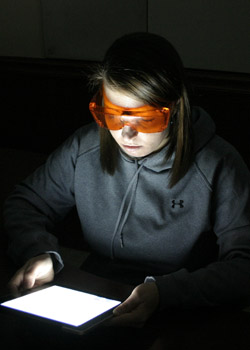In 2012, the Lighting Research Center (LRC) at Rensselaer Polytechnic Institute published a study that changed the way we think about using “self-luminous devices” such as tablets, laptops and e-readers at night. The study led by Professor Mariana Figueiro, Light & Health program director at the LRC, found that light from tablets can affect evening melatonin and, therefore, may delay sleep. The research results were widely covered by the news media, with stories appearing in The New York Times, Los Angeles Times, New York Daily News, The Washington Post, Huffington Post, Scientific American, The Economist, and other major news organizations around the world.
Figueiro conducted a follow-up study and has published a new paper, titled, “Self-luminous devices and melatonin suppression in adolescents,” in the journal, Lighting Research & Technology. The new study was the first to be conducted in the home environment that investigated the effects of self-luminous devices on melatonin levels in adolescents. Results show that 1-hour exposure to light from self-luminous devices suppressed melatonin by approximately 23 percent, and 2-hour exposure suppressed melatonin by approximately 38 percent.
 |
|
Adolescents are more senstive to the same level of blue light exposure compared to adults. |
While the measured light exposure was about the same, the melatonin suppression was higher than what was observed in the 2012 study, which suggests that adolescents are more sensitive than adults to light from self-luminous devices. Melatonin suppression can negatively impact an individual’s ability to fall asleep by delaying the timing of sleep onset.
“One of the most striking findings from the present study was that adolescents seem to have a heightened sensitivity to evening light for acute melatonin suppression,” said Figueiro. “Although the light levels were similar, the amount of suppression observed in the present study was much higher than that observed in adults in previous studies conducted at the LRC.”
For the new study, 20 adolescents (aged 15-17 years) viewed self-luminous devices through orange-tinted glasses that filter out short-wavelength light, and then viewed the same self-luminous devices without orange-tinted glasses. The orange-tinted glasses served as a “dark” control condition since they remove short-wavelength light that suppresses melatonin production. Each participant also wore a Daysimeter—a calibrated, personal light and activity sensor developed by the LRC—to measure circadian light and quantify circadian entrainment or disruption. The participants were allowed to use computers, tablets, e-readers, televisions, and mobile phones.
 |
|
Subjects melatonin levels were measured after they read tablets wearing different tinted color glasses. |
Self-luminous devices, such as those used in this study, can emit short-wavelength (blue) light, which maximally suppresses melatonin. Exposure to this light in the evening and at night may lead to acute suppression and delay the timing of melatonin production, both of which are believed to be detrimental to sleep quantity and quality.
“If we want to have a good night of sleep, we should keep a regular schedule, increase the amount of circadian light exposure during the daytime hours, and reduce it during the evening hours,” said Figueiro. “Try to limit the use of self-luminous devices two hours prior to bedtime. If that is not possible, dim down the screen brightness, or filter out the short-wavelength light by adding theatrical gels to the device, or by wearing orange-tinted glasses. These simple actions may result in earlier bedtimes that could help improve mood, wellbeing, and perhaps even school performance.”













